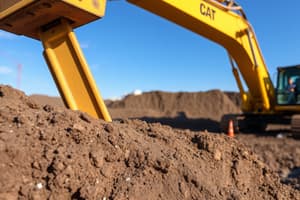Podcast
Questions and Answers
______ signs should be placed to warn people of the excavation.
______ signs should be placed to warn people of the excavation.
Warning
The walls of every excavation over 1 m (3 ft) deep should be supported by adequate ______ and timbering to prevent collapse.
The walls of every excavation over 1 m (3 ft) deep should be supported by adequate ______ and timbering to prevent collapse.
shoring
Workers shall not enter any excavation over 4 ft in depth unless the sides are sloped to a safe angle. No slope can be steeper than _____ ft horizontal to 4 ft vertical.
Workers shall not enter any excavation over 4 ft in depth unless the sides are sloped to a safe angle. No slope can be steeper than _____ ft horizontal to 4 ft vertical.
3
An Experienced and Trained Worker is designated to directly supervise each excavation project to ensure compliance with sloping and ______ requirements
An Experienced and Trained Worker is designated to directly supervise each excavation project to ensure compliance with sloping and ______ requirements
Every part of an excavation over 2 m deep where workers work shall be inspected for evidence of a situation that could result in an accident, including compliance with ______ requirements
Every part of an excavation over 2 m deep where workers work shall be inspected for evidence of a situation that could result in an accident, including compliance with ______ requirements
Top of the walls of an excavation more than 2.0 m deep shall be barricaded to a height of at least 1 m to prevent the fall of workers, meeting ______ requirements
Top of the walls of an excavation more than 2.0 m deep shall be barricaded to a height of at least 1 m to prevent the fall of workers, meeting ______ requirements
______ is a form of driven piling using thin interlocking sheets of steel to obtain a continuous barrier in the ground.
______ is a form of driven piling using thin interlocking sheets of steel to obtain a continuous barrier in the ground.
________ means to protect workers by using trench boxes or other types of supports to prevent soil cave-ins.
________ means to protect workers by using trench boxes or other types of supports to prevent soil cave-ins.
________ involves protecting workers from cave-ins by excavating the sides of an excavation to form horizontal levels or steps.
________ involves protecting workers from cave-ins by excavating the sides of an excavation to form horizontal levels or steps.
________ is a support system designed to keep the sides of an excavation from caving in, and should be installed from top down and removed from bottom up.
________ is a support system designed to keep the sides of an excavation from caving in, and should be installed from top down and removed from bottom up.
Flashcards are hidden until you start studying
Study Notes
Excavation Safety Regulations
- Signs should be placed to warn people of the excavation.
- Walls of every excavation over 1 m (3 ft) deep should be supported by adequate shoring and timbering to prevent collapse.
Sloping and Shielding Requirements
- Workers shall not enter any excavation over 4 ft in depth unless the sides are sloped to a safe angle.
- No slope can be steeper than 1.5 ft horizontal to 4 ft vertical.
Supervision and Inspection
- An Experienced and Trained Worker should be designated to directly supervise each excavation project to ensure compliance with sloping and shielding requirements.
- Every part of an excavation over 2 m deep should be inspected for evidence of a situation that could result in an accident, including compliance with sloping requirements.
Barricading and Support Systems
- Top of the walls of an excavation more than 2.0 m deep should be barricaded to a height of at least 1 m to prevent the fall of workers, meeting safety requirements.
- Sheet piling is a form of driven piling using thin interlocking sheets of steel to obtain a continuous barrier in the ground.
- Shielding means to protect workers by using trench boxes or other types of supports to prevent soil cave-ins.
- Benching involves protecting workers from cave-ins by excavating the sides of an excavation to form horizontal levels or steps.
- Shoring is a support system designed to keep the sides of an excavation from caving in, and should be installed from top down and removed from bottom up.
Studying That Suits You
Use AI to generate personalized quizzes and flashcards to suit your learning preferences.




